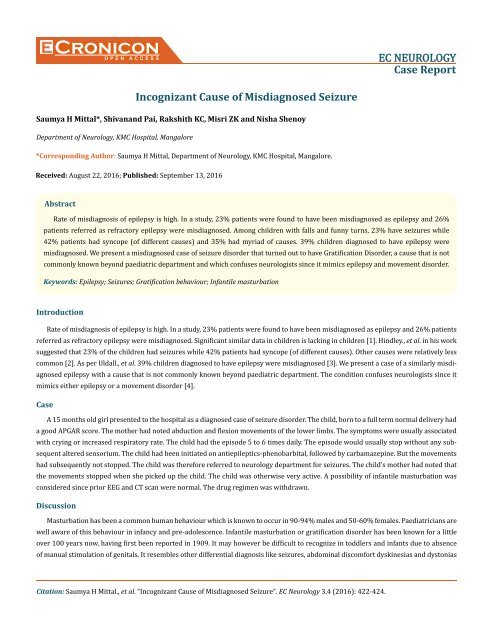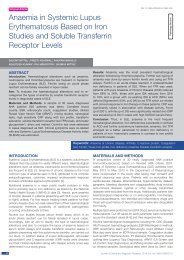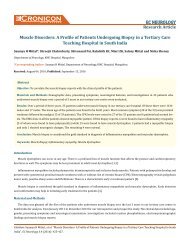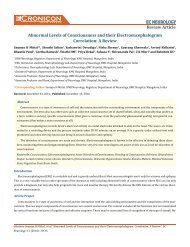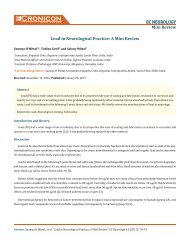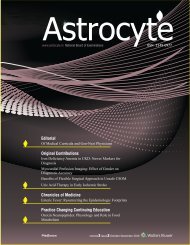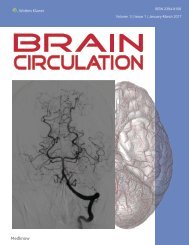Incognizant Cause of Misdiagnosed Seizure
Create successful ePaper yourself
Turn your PDF publications into a flip-book with our unique Google optimized e-Paper software.
Cronicon<br />
OPEN ACCESS<br />
EC NEUROLOGY<br />
Case Report<br />
<strong>Incognizant</strong> <strong>Cause</strong> <strong>of</strong> <strong>Misdiagnosed</strong> <strong>Seizure</strong><br />
Saumya H Mittal*, Shivanand Pai, Rakshith KC, Misri ZK and Nisha Shenoy<br />
Department <strong>of</strong> Neurology, KMC Hospital, Mangalore<br />
*Corresponding Author: Saumya H Mittal, Department <strong>of</strong> Neurology, KMC Hospital, Mangalore.<br />
Received: August 22, 2016; Published: September 13, 2016<br />
Abstract<br />
Rate <strong>of</strong> misdiagnosis <strong>of</strong> epilepsy is high. In a study, 23% patients were found to have been misdiagnosed as epilepsy and 26%<br />
patients referred as refractory epilepsy were misdiagnosed. Among children with falls and funny turns, 23% have seizures while<br />
42% patients had syncope (<strong>of</strong> different causes) and 35% had myriad <strong>of</strong> causes. 39% children diagnosed to have epilepsy were<br />
misdiagnosed. We present a misdiagnosed case <strong>of</strong> seizure disorder that turned out to have Gratification Disorder, a cause that is not<br />
commonly known beyond paediatric department and which confuses neurologists since it mimics epilepsy and movement disorder.<br />
Keywords: Epilepsy; <strong>Seizure</strong>s; Gratification behaviour; Infantile masturbation<br />
Introduction<br />
Rate <strong>of</strong> misdiagnosis <strong>of</strong> epilepsy is high. In a study, 23% patients were found to have been misdiagnosed as epilepsy and 26% patients<br />
referred as refractory epilepsy were misdiagnosed. Significant similar data in children is lacking in children [1]. Hindley., et al. in his work<br />
suggested that 23% <strong>of</strong> the children had seizures while 42% patients had syncope (<strong>of</strong> different causes). Other causes were relatively less<br />
common [2]. As per Uldall., et al. 39% children diagnosed to have epilepsy were misdiagnosed [3]. We present a case <strong>of</strong> a similarly misdiagnosed<br />
epilepsy with a cause that is not commonly known beyond paediatric department. The condition confuses neurologists since it<br />
mimics either epilepsy or a movement disorder [4].<br />
Case<br />
A 15 months old girl presented to the hospital as a diagnosed case <strong>of</strong> seizure disorder. The child, born to a full term normal delivery had<br />
a good APGAR score. The mother had noted abduction and flexion movements <strong>of</strong> the lower limbs. The symptoms were usually associated<br />
with crying or increased respiratory rate. The child had the episode 5 to 6 times daily. The episode would usually stop without any subsequent<br />
altered sensorium. The child had been initiated on antiepileptics-phenobarbital, followed by carbamazepine. But the movements<br />
had subsequently not stopped. The child was therefore referred to neurology department for seizures. The child’s mother had noted that<br />
the movements stopped when she picked up the child. The child was otherwise very active. A possibility <strong>of</strong> infantile masturbation was<br />
considered since prior EEG and CT scan were normal. The drug regimen was withdrawn.<br />
Discussion<br />
Masturbation has been a common human behaviour which is known to occur in 90-94% males and 50-60% females. Paediatricians are<br />
well aware <strong>of</strong> this behaviour in infancy and pre-adolescence. Infantile masturbation or gratification disorder has been known for a little<br />
over 100 years now, having first been reported in 1909. It may however be difficult to recognize in toddlers and infants due to absence<br />
<strong>of</strong> manual stimulation <strong>of</strong> genitals. It resembles other differential diagnosis like seizures, abdominal discomfort dyskinesias and dystonias<br />
Citation: Saumya H Mittal., et al. “<strong>Incognizant</strong> <strong>Cause</strong> <strong>of</strong> <strong>Misdiagnosed</strong> <strong>Seizure</strong>”. EC Neurology 3.4 (2016): 422-424.
<strong>Incognizant</strong> <strong>Cause</strong> <strong>of</strong> <strong>Misdiagnosed</strong> <strong>Seizure</strong><br />
and therefore unrecognized gratification disorder may result into extensive and expensive workup and wrong initiation <strong>of</strong> treatment with<br />
antiepileptic drugs etc. [4-6].<br />
423<br />
Gratification disorder may be frequently seen in children after age <strong>of</strong> 2 to 3 months. Frequently, these children are deprived <strong>of</strong> tactile<br />
sensory domain. Our patient would stop the movements when picked up by the mother. This may be explained by this phenomenon. The<br />
other cause may be child sexual abuse. Many authors have considered other conditions like sleep disorders, genitourinary irritations, and<br />
even early weaning from breast feeding as a cause [4,6,7].<br />
The patient may show adduction <strong>of</strong> thighs, eidetic imagery, grunting, rocking, sweating and occasionally twitching and pelvic thrusting.<br />
The lack <strong>of</strong> genital stimulation <strong>of</strong>ten confuses the physicians misleading them to diagnose a condition other than infantile masturbation.<br />
It may help the physicians if they consider that torsional posturing, rocking and cessation on distraction is uncommon in seizures.<br />
These children appear annoyed if interrupted. Some children display facial flushing, cyanosis, lip smacking, staring, shaking, pallor, giggling,<br />
and frightened appearance [4,5,7].<br />
It also confuses movement disorder specialists when it resembles paroxysmal dystonic choreoathetosis [4].<br />
This may become a habit when the child is bored or sleepy. No children have been reported to develop seizures subsequently. However,<br />
variations in behavioural manifestations may be noted as the child grows up. An association with ADHD may be noted as the child<br />
grows up. The lack <strong>of</strong> motor and cognitive abilities may preclude manifestation <strong>of</strong> ADHD in infants. Once diagnosed, the parents need<br />
to be counselled and educated about this normal behaviour. They should be informed that this can subside when the child is engaged in<br />
another activity in his environment [4,7].<br />
Conclusion<br />
Misdiagnosis <strong>of</strong> seizure is very common. The main reasons for this are:<br />
1. Most frequently, diagnosis is based on history while the examination may be frequently normal.<br />
2. The differential diagnosis <strong>of</strong> seizures is large and there is no confirmatory test for seizures. Frequently, the basic tests may simply be<br />
unavailable to a treating physician.<br />
3. Physicians may either not have enough knowledge about differentials <strong>of</strong> the seizures, or may be apprehensive about missing a diagnosis<br />
<strong>of</strong> seizures thereby over diagnosing the syndrome [1].<br />
It is important to avoid misdiagnosing or over diagnosing epilepsy. Wrong diagnosis can be detrimental. Many leisure activities, pr<strong>of</strong>essional<br />
or educational prospects may be restricted. Patients are subjected to the side effects <strong>of</strong> the antiepileptic drugs. Correct diagnosis<br />
and treatment are denied, and in many cases patients may not need treatment. Only explaining the condition to patient or parents (like in<br />
our case) and reassurance may be needed [1,3].<br />
In children, the diagnosis <strong>of</strong> seizure should be made by a specialist- a paediatrician trained in the expertise <strong>of</strong> epilepsy [8].<br />
Gratification disorder should be considered as a differential diagnosis in a case suspected with seizures if the episodes develop between<br />
age <strong>of</strong> 3 months and 3 years with aforementioned signs and symptoms, lower limb posturing, normal examination and laboratory<br />
reports.<br />
Citation: Saumya H Mittal., et al. “<strong>Incognizant</strong> <strong>Cause</strong> <strong>of</strong> <strong>Misdiagnosed</strong> <strong>Seizure</strong>”. EC Neurology 3.4 (2016): 422-424.
<strong>Incognizant</strong> <strong>Cause</strong> <strong>of</strong> <strong>Misdiagnosed</strong> <strong>Seizure</strong><br />
424<br />
Bibliography<br />
1. Ferrie CD. “Preventing misdiagnosis <strong>of</strong> epilepsy”. Archives <strong>of</strong> Disease in Childhood 91.3 (2006): 206-209.<br />
2. Hindley D., et al. “Diagnoses made in a secondary care ‘‘fits, faints, and funny turns’’ clinic”. Archives <strong>of</strong> Disease in Childhood 91.3<br />
(2006): 214-218.<br />
3. Uldall P., et al. “The misdiagnosis <strong>of</strong> epilepsy in children admitted to a tertiary epilepsy centre with paroxysmal events”. Disease in<br />
Childhood 91.3 (2006): 219-221.<br />
4. Mohammedreza Salehi Omran., et al. “Infantile Masturbation and Paroxysmal Disorders”. Indian Journal <strong>of</strong> Pediatrics 75.2 (2008):<br />
183-185.<br />
5. A Nechay., et al. “Gratification disorder (‘‘infantile masturbation’’): a review”. Archives <strong>of</strong> Disease in Childhood 89 (2004): 225-226.<br />
6. Tomislav Franić & Ivana Ujević Franić. “Infantile masturbation - exclusion <strong>of</strong> severe diagnosis does not exclude parental distress -<br />
case report”. Psychiatria Danubina 23.4 (2011): 398-399.<br />
7. Mohammed M Jan., et al. “Long-term Outcome <strong>of</strong> Infantile Gratification Phenomena”. The Canadian Journal <strong>of</strong> Neurological Sciences<br />
40.3 (2013): 416-419.<br />
8. NICE. “The epilepsies: The diagnosis and management <strong>of</strong> the epilepsies in adults and children in primary and secondary care: Pharmacological<br />
Update <strong>of</strong> Clinical Guideline 20”. National Clinical Guideline Centre (UK) (2012).<br />
Volume 3 Issue 4 September 2016<br />
© All rights reserved by Saumya H Mittal., et al.<br />
Citation: Saumya H Mittal., et al. “<strong>Incognizant</strong> <strong>Cause</strong> <strong>of</strong> <strong>Misdiagnosed</strong> <strong>Seizure</strong>”. EC Neurology 3.4 (2016): 422-424.


